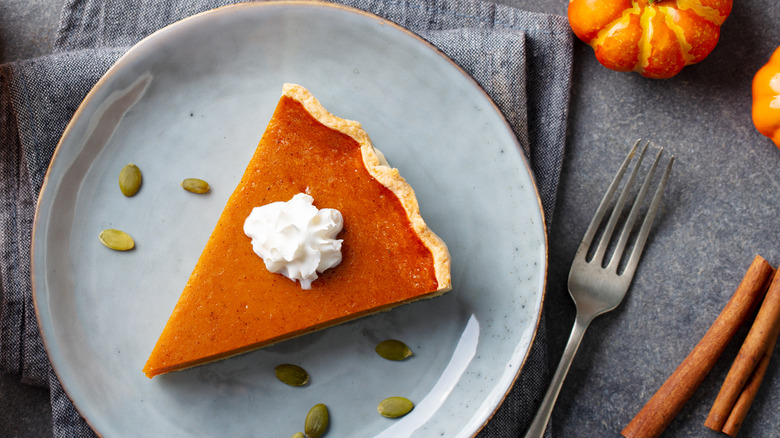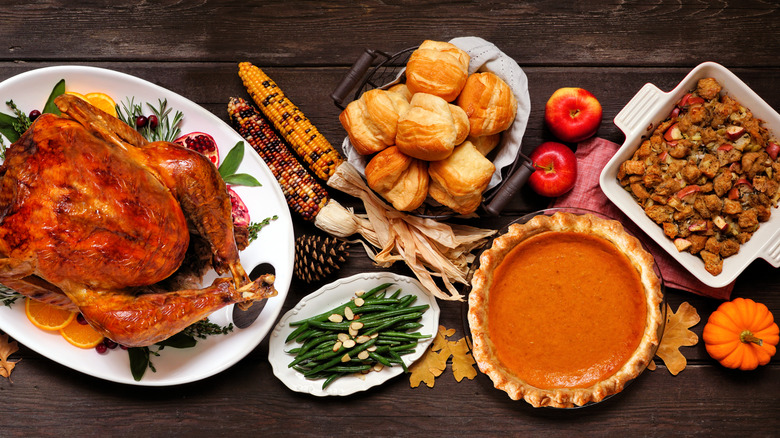The Surprising Connection Between Pumpkin Pie And 19th-Century Abolitionists
Mmm... Pumpkin pie! The creamy, crusty, quintessential fall dessert is made with a blend of warm spices that, when combined, create a flavor that instantly brings comfort to the eater. It's virtually impossible not to find mountains of pumpkin pies or pumpkin spiced goods in grocery stores, bakeries, or on dining tables during the holiday season. So, how did this iconic pie come to be? And what real significance does it play in American culture?
Pumpkins were first brought to the public scene in 1536, according to History. They soon became an abundant crop in England. The round, orange gourds were originally called "pumpions," a variation of the French term "pompon." Meanwhile, across the pond, Americans called them pumpkins. England was (and still is) known for its intricate pies, which eventually involved pumpkins. The first pumpkin pies, as one can imagine, tasted a bit different from today's versions. Hannah Woolley, a famous English writer who is often considered a pioneer in home economics, had written a recipe for a pie that calls for pumpkin, tart apples, thyme, rosemary, marjoram, cinnamon, nutmeg, pepper, cloves, raisins, dried currants, and sherry in her 1673 book, "The Gentlewoman's Companion: A Guide to the Female Sex" (per ManyEats).
Yet, this seemingly innocent autumnal treat has quite a history behind it if you fast-forward a couple of centuries and transport to America — one that may change your perception.
Pumpkin pie and the anti-slavery movement
The mid-19th century was a landmark time of turmoil. For one, the American Civil War (1861-1865) erupted after decades of tensions between northern and southern states over the legality and ethics of slavery. It was also during this era in which pumpkin pie rose in popularity stateside, particularly in the northern states. Most abolitionists — those who opposed slavery — resided in New England. In reality, pumpkin pie was posed as politically significant, as it was injected into the country's tumultuous debate over slavery.
An abolitionist woman by the name of Sarah Josepha Hale explicitly mentioned pumpkin pie in her 1827 anti-slavery novel "Northwood: A Tale of New England." The scene describes a Thanksgiving dinner table filled with classic fare. "The pumpkin pie occupied the most distinguished niche," the book states (per History). Lydia Maria Child, another renowned abolitionist, wrote a poem in 1842 about a New England Thanksgiving, titled "Over the River and Through the Wood." The cheerful rhyme ends with, "Hurra for the pumpkin pie!" (via Poetry Foundation).
Abraham Lincoln officially named Thanksgiving a national holiday in 1863 in an effort to express gratitude for a Union Army victory at Gettysburg (via History). Confederates believed the declaration was an attempt to forcibly infuse Yankee traditions in the South. An editorialist in Richmond, Virginia, even penned, "This is an annual custom of that people, heretofore celebrated with devout oblations to themselves of pumpkin pie and roast turkey" (via History). Thanksgiving was added to more and more families' calendars post-Civil War, and over time, became a pinnacle of American culture. In addition to turkey, stuffing, cranberry sauce, and potatoes, pumpkin pie has remained a Thanksgiving staple.

